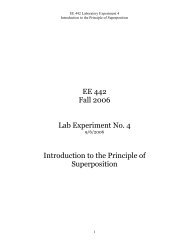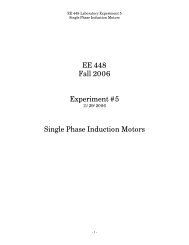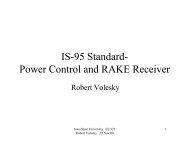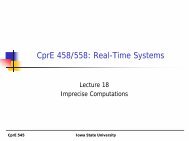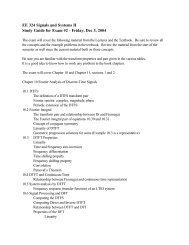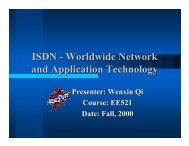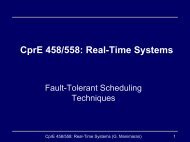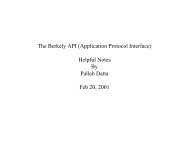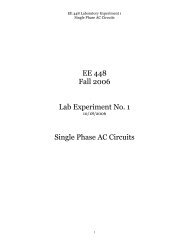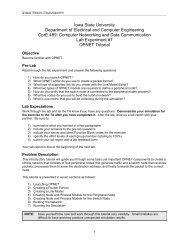S. Norden et al. / Computer Communications 22 (1999) 128–136 133Fig. 2. Effect of load on (a) SR,(b) ECU,(c) NTL.successfully. In the simulation plots, these <strong>protocols</strong> arelabelled as with an extension BE to <strong>in</strong>dicate ‘‘Best Ef<strong>for</strong>t’’.For the sake of completeness, we describe the PBCSMAprotocol as given below:The PBCSMA protocol• A message is characterized as critical, if its laxity is lessthan a predef<strong>in</strong>ed threshold, otherwise it is classified asnon-critical.• Transmission of a critical message beg<strong>in</strong>s with the broadcastof a notifier, similar to our protocol.• When a new message arrives and is classified as eithercritical or non-critical, and the channel is idle, themessage is sent. Otherwise (i.e., the channel is busy),if the message currently be<strong>in</strong>g transmitted is not critical,it is preempted to allow a critical message to besent.• Transmission of a non-critical message from a node isnot possible as long as the channel is busy. Also, themessage is not sent right after the channel becomesidle. The node waits <strong>for</strong> one slot, and if the channelrema<strong>in</strong>s idle, the message is sent.• Follow<strong>in</strong>g a collision, a non-critical message issuspended <strong>for</strong> the duration of a slot, and if that slot isnot occupied by a critical message, the non-criticalmessage is retransmitted with probability P i .• If a critical message collides, it is retransmitted immediatelywith probability P i .From the Figs. 2(a)–5(a), it can be observed that the SRoffered by LDCR is better than the other two <strong>protocols</strong> ofwhich the MDCR is better than PBCSMA. From Figs. 3(b)–5(b), the ECU obta<strong>in</strong>ed us<strong>in</strong>g LDCR is higher (better) thanthe other two because of its SR. Similarly, the NTL offeredby LDCR is closer to one as compared to the other <strong>protocols</strong>.The reasons <strong>for</strong> these observations are discussedbelow:• LDCR is better than PBCSMA: The reasons, why LDCRis an improvement over PBCSMA, are as follows. In thecase of the notifier of a critical message collid<strong>in</strong>g with thenotifier transmission of another critical message,PBCSMA will retransmit the <strong>in</strong>terrupted message withcerta<strong>in</strong> probability. When the threshold is large, onecould have several critical messages which require tobe transmitted. Repeated attempts at retransmission withoutproper arbitration <strong>in</strong> the CSMA fashion will lead toseveral collisions utiliz<strong>in</strong>g several slots which <strong>in</strong> turnleads to miss<strong>in</strong>g of message deadl<strong>in</strong>es. Whereas <strong>in</strong>LDCR-BE, by <strong>for</strong>c<strong>in</strong>g the threshold <strong>for</strong> critical messagesto be one, the protocol restricts the number of criticalmessages; <strong>in</strong> the event of collision, the arbitration isdone as per the pre order traversal of the CR treeFig. 3. Effect of a on (a) SR, (b) ECU, (c) NTL.
134S. Norden et al. / Computer Communications 22 (1999) 128–136Fig. 4. Effect of N on (a) SR,(b) ECU,(c) NTL.allow<strong>in</strong>g one of the nodes to transmit <strong>in</strong> subsequent slotswithout wast<strong>in</strong>g the bandwidth. Further, <strong>in</strong> LDCR, whentwo critical messages have laxities less than the thresholdvalue, the smaller message is transmitted whichimproves the chances of subsequent messages. AsPBCSMA is a preemption based protocol, if a non-criticalmessage is preempted as result of the presence ofseveral critical messages, the assumption made <strong>in</strong> [15]is that the non-critical message will have a large enoughdeadl<strong>in</strong>e so as to still be transmitted after all the criticalmessages. This will not hold especially when the thresholdis large and there are a large number of criticalmessages wait<strong>in</strong>g <strong>for</strong> channel access. The subsequentdelay <strong>in</strong>curred by the non-critical message may make itcritical, lead<strong>in</strong>g to degradation <strong>in</strong> the protocol as thenumber of critical messages steadily <strong>in</strong>creases. Another<strong>in</strong>terest<strong>in</strong>g observation about PBCSMA that re<strong>in</strong><strong>for</strong>cesthe above po<strong>in</strong>t, also made by the author <strong>in</strong> [15], is thatthe SR will degrade when the threshold is <strong>in</strong>creasedbeyond a certa<strong>in</strong> value, as the number of criticalmessages (with vary<strong>in</strong>g degree of criticality) <strong>in</strong>creases.This results <strong>in</strong> <strong>in</strong>creased number of collisions betweenthese messages, thereby reduc<strong>in</strong>g the SR. The <strong>in</strong>creasednumber of collisions will also result <strong>in</strong> a lower ECUvalue. In addition, it may also result <strong>in</strong> priority <strong>in</strong>version,as high laxity (non-critical) messages would contend <strong>for</strong>the channel along with low laxity (critical) messages.The <strong>in</strong>creased number of collisions will also result<strong>in</strong> a lower ECU value. This situation will not arise<strong>in</strong> LDCR, as it defers the non-critical messages to aseparate mode (LLF), thus avoid<strong>in</strong>g collisions betweenmessages with high and low laxities. This will reducethe number of overall collisions. These deferredmessages are transmitted <strong>in</strong> the LLF mode, us<strong>in</strong>glaxity based order<strong>in</strong>g. This systematic way of collisionresolution and message deferment results <strong>in</strong> improvedSR and ECU. The superiority of the LDCR protocolover PBCSMA, can be clearly seen, from all the simulationgraphs.• LDCR is better than MDCR: The relatively poor per<strong>for</strong>manceof MDCR is ow<strong>in</strong>g to its bl<strong>in</strong>d transmission ofmessages as per the static position of nodes <strong>in</strong> the CR treewithout tak<strong>in</strong>g <strong>in</strong>to account the laxity of messages amongthe nodes. Thus higher priority (lower laxity) messageswill be treated <strong>in</strong> the same way as lower priority (largelaxity) messages. This will lead to miss<strong>in</strong>g of messagedeadl<strong>in</strong>es. Further, a large number of messages with tighterlaxity, hav<strong>in</strong>g small service <strong>time</strong>s, could be dropped ifa message with larger laxity, and hav<strong>in</strong>g larger service<strong>time</strong>, is transmitted. This scenario is brought out by thehigh NTL values, shown by the MDCR protocol, <strong>in</strong> Figs.2(c)–5(c). From the Figs. 2(a)–5(a), which study theFig. 5. Effect of P/Nt ratio on (a) SR,(b) ECU,(c) NTL.



